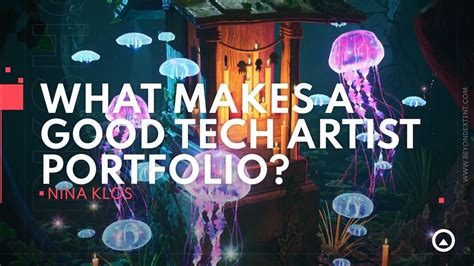In today's digital age, having a strong online presence is crucial for any artist, especially those in the tech industry. A well-crafted portfolio can make all the difference in showcasing your skills, attracting potential clients, and standing out in a competitive market. As a tech artist, your portfolio is often the first impression you make on potential employers or clients, so it's essential to get it right. Here are 7 essential pieces to include in your tech artist portfolio:
1. A Strong Online Platform

Your online platform is the foundation of your portfolio. It's where you'll showcase your work, share your story, and connect with potential clients or employers. Choose a platform that's easy to use, customizable, and optimized for search engines. Popular options include WordPress, Wix, and Squarespace.
Key Features to Consider:
- Responsive design that adapts to different devices and screen sizes
- Easy navigation and clear categorization of your work
- Search engine optimization (SEO) to improve visibility
- Integration with social media and other online platforms
2. A Clear and Concise Artist Statement

Your artist statement is a brief introduction to your work, highlighting your unique style, inspirations, and creative vision. It should be concise, clear, and free of jargon. Use this opportunity to tell your story, share your passions, and showcase your personality.
Tips for Writing a Strong Artist Statement:
- Keep it concise and focused on your core message
- Use simple language that's easy to understand
- Avoid clichés and overused phrases
- Use active voice and a conversational tone
3. A Curated Selection of Your Best Work

Your portfolio should showcase your best work, demonstrating your skills, creativity, and attention to detail. Curate a selection of pieces that showcase your versatility, technical abilities, and artistic vision. Make sure to include a variety of projects that demonstrate your range and expertise.
Key Considerations for Selecting Your Best Work:
- Choose pieces that demonstrate your technical skills and artistic vision
- Select projects that showcase your versatility and range
- Consider including case studies or project descriptions to provide context
- Ensure that your work is well-presented, with high-quality images and clear captions
4. Case Studies and Project Descriptions

Case studies and project descriptions provide valuable context for your work, helping potential clients or employers understand your process, challenges, and solutions. Use these opportunities to share your creative decisions, technical approaches, and problem-solving strategies.
Tips for Writing Effective Case Studies and Project Descriptions:
- Keep it concise and focused on the key takeaways
- Use clear, simple language that's easy to understand
- Include relevant images, diagrams, or screenshots to illustrate your points
- Use active voice and a conversational tone
5. Testimonials and Feedback from Clients or Colleagues

Testimonials and feedback from clients or colleagues provide valuable social proof, helping to establish your credibility and reputation. Use these endorsements to demonstrate your skills, work ethic, and professionalism.
Key Considerations for Including Testimonials and Feedback:
- Choose testimonials that are specific, sincere, and relevant to your work
- Use quotes or short statements that are easy to read and understand
- Include the name, title, and company of the person providing the testimonial
- Consider including images or logos to add visual interest
6. A Clear and Easy-to-Use Contact Form

Your contact form is the gateway to new opportunities, allowing potential clients or employers to get in touch with you. Make sure it's easy to use, clear, and concise. Include all the necessary fields, such as name, email, and message.
Key Considerations for Creating a Clear and Easy-to-Use Contact Form:
- Keep it simple and easy to use
- Include all the necessary fields, such as name, email, and message
- Use clear and concise language in your form labels and instructions
- Consider including a spam filter or CAPTCHA to prevent unwanted messages
7. A Professional Online Presence Beyond Your Portfolio

Your online presence extends beyond your portfolio, encompassing social media, online communities, and other digital platforms. Establish a consistent brand identity across all your online channels, ensuring that your message, tone, and visual aesthetic are cohesive and professional.
Key Considerations for Establishing a Professional Online Presence:
- Use consistent branding across all your online channels
- Engage with your audience and participate in online communities
- Share your work, provide value, and demonstrate your expertise
- Use social media analytics to track your performance and adjust your strategy
Gallery of Tech Artist Portfolio Examples:






FAQ Section:
What is a tech artist portfolio?
+A tech artist portfolio is a collection of an artist's work, showcasing their skills, creativity, and technical abilities in the tech industry.
Why do I need a tech artist portfolio?
+A tech artist portfolio is essential for establishing your credibility, showcasing your work, and attracting potential clients or employers in the tech industry.
What should I include in my tech artist portfolio?
+Your tech artist portfolio should include a strong online platform, a clear and concise artist statement, a curated selection of your best work, case studies and project descriptions, testimonials and feedback from clients or colleagues, a clear and easy-to-use contact form, and a professional online presence beyond your portfolio.
In conclusion, a well-crafted tech artist portfolio is essential for establishing your credibility, showcasing your work, and attracting potential clients or employers in the tech industry. By including these 7 essential pieces, you'll be well on your way to creating a portfolio that showcases your skills, creativity, and technical abilities.
